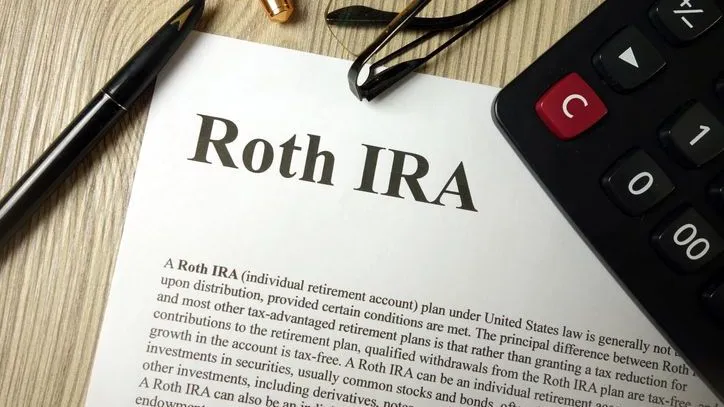Do funds in a Roth IRA get the benefit of a stepped-up basis for my heirs when I die?
– Ed
No, the cost basis of the assets held within your IRA will not step up or reset to their current market value when you pass away. A step-up in basis only applies to assets and property held outside of retirement accounts. However, that’s really a non-issue because Roth IRA beneficiaries don’t pay taxes on qualified withdrawals from the account anyway. Let’s take a closer look at this topic.
Need help with your financial plan for retirement? Match with a fiduciary financial advisor today and how they can potentially get you ready for your golden years.
Understanding Cost Basis
An investment’s basis is the starting point from which you calculate your gain for tax purposes. It’s generally the price you pay for something. But, if the purchase incurred transaction costs or expenses associated with making the purchase, you include those in your basis as well. Some examples of transaction costs that you include in the cost basis of an asset are commissions, recording fees and transfer fees.
This all determines whether you have a capital gain or loss when you – or your heirs – eventually sell the asset.
Here’s how it works:
Suppose you buy a stock for $125 per share – that’s your cost basis. If the stock goes up to $150 per share, your gain is $25 per share. If you sell the share, that $25 is taxable. However, it the stock falls to $100 per share and you sell it, you’ll record a $25 loss, which can potentially offset other capital gains. (If you need help planning around when to sell an investment, consider speaking with a financial advisor.)
What Is a Step-Up in Basis?
The step-up in basis is a concept that applies when assets transfer to an heir upon a person’s death. Generally, the basis of an inherited asset “steps-up” to the fair market value on the date of death. This can lead to significant tax savings for beneficiaries.
For example, imagine that a 90-year old woman owns a piece of land that she bought 60 years ago for $10,000. Let’s assume the property is worth $180,000 today, which isn’t a stretch just considering historical inflation.
The owner has a basis of $10,000, which means her gain (unrealized until she sells the property) is $170,000. If the woman dies and leaves the land to a beneficiary, that beneficiary’s basis will step up to the current fair market value of $180,000. If that heir then sells the land for $180,000 they will have no taxable gain.
However, if the heir sells the property for $200,000, they’ll realize a $20,000 gain that will be taxable. (And if you need help planning around both capital gains and income taxes, consider finding a financial advisor with tax expertise.)
Why Do Assets in Roth IRAs Not ‘Step Up’?

Retirement accounts like IRAs and Roth IRAs offer tax advantages that shield assets from taxes while they remain in the account. Dividends, interest and capital gains generated within these accounts typically grow tax-deferred or tax-free. Taxes are only triggered when you withdraw funds, with traditional accounts subjecting withdrawals to income tax, while Roth accounts allow tax-free withdrawals if certain conditions are met.
The tax treatment of IRA withdrawals is unrelated to the cost basis of the underlying assets. Instead, the tax liability depends on the type of account and whether withdrawals are taken. Traditional IRAs are taxed as ordinary income, while Roth IRAs, having been funded with after-tax dollars, generally have no tax liability on qualified withdrawals.
While it doesn’t affect our conversation here, I want to note that there are some notable exceptions to this general rule, such as non-deductible IRA contributions in traditional IRAs or non-qualified Roth IRA withdrawals. (Consider working with a financial advisor on how to optimize your retirement withdrawal strategy.)
Withdrawals From an Inherited Roth IRA
When your heirs inherit the Roth IRA, they will generally have to withdraw the value of that account within 10 years. If you leave it to a spouse, they will have the additional option of rolling it into an account in their own name and avoiding the 10-year rule.
In most cases your heirs will not owe taxes on those withdrawals if the account has been open for at least five years. If the account has not been open for five years, withdrawn investment gains may be subject to income tax.
Either way, the basis doesn’t matter. (If you’ve inherited an IRA, consider matching with a financial advisor for help managing your withdrawals from the account.)
Bottom Line

The basis of assets held within a Roth IRA does not step up at the owner’s death. However, Roth IRA beneficiaries typically do not owe any taxes on withdrawals provided certain conditions are met.
Retirement Planning Tips
- If you have a tax-deferred retirement account like a traditional IRA or 401(k), it’s important to plan for required minimum distributions (RMDS). These mandatory withdrawals, which start when you reach age 73 (age 75 for people born in 1960 or later), increase your taxable income. Failing to take the proper RMD can also result in a tax penalty. SmartAsset’s RMD calculator can help you estimate how much your first RMD could be.
- Planning for retirement can be a complex puzzle, but working with a financial advisor who specializes in retirement planning can help you put the pieces together. Finding a financial advisor doesn’t have to be hard. SmartAsset’s free tool matches you with up to three vetted financial advisors who serve your area, and you can have a free introductory call with your advisor matches to decide which one you feel is right for you. If you’re ready to find an advisor who can help you achieve your financial goals, get started now.
- Are you a financial advisor looking to improve your marketing? SmartAsset AMP (Advisor Marketing Platform) is a holistic marketing service financial advisors can use for client lead generation and automated marketing. Sign up for a free demo to explore how SmartAsset AMP can help you expand your practice’s marketing operation. Get started today.
Brandon Renfro, CFP®, is a SmartAsset financial planning columnist and answers reader questions on personal finance and tax topics. Got a question you’d like answered? Email AskAnAdvisor@smartasset.com and your question may be answered in a future column.
Please note that Brandon is not an employee of SmartAsset and is not a participant in SmartAsset AMP. He has been compensated for this article. Some reader-submitted questions are edited for clarity or brevity.
Photo credit: ©iStock.com/Love portrait and love the world, ©iStock.com/
